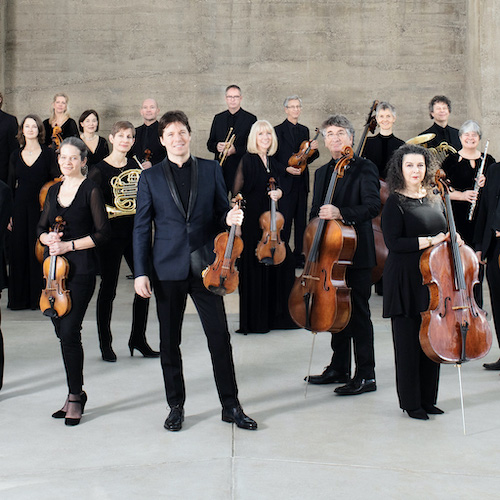Bell and the Academy team up for fervent Dvořak, superficial Beethoven at Arsht Center

There is nothing like star power to draw an audience to a classical music concert. On Saturday night, Joshua Bell and the Academy of St. Martin in the Fields were greeted by a well-populated crowd at the Arsht Center for the opening of a weeklong performance and educational residency.
Bell is one of the world’s leading virtuoso violinists who has transcended the elite concert world to global celebrity with ongoing crossover recordings and television appearances. In recent years, he has been turning to orchestral direction, albeit from the concertmaster’s seat rather than a podium. The concert amply displayed Bell’s playing was sure and masterful as ever—and his musical direction considerably less so.
Dvořak’s Violin Concerto in A minor is one of those grandly romantic, unabashedly bravura works that had fallen off the programming radar but have been making a comeback in recent years. Bell has taken up the score’s cause and it is precisely the type of vehicle that he excels at.
In the concerto’s first movement, Bell’s beauty of tone and near-flawless technique generated the yearning and nostalgia that pervades the music. His performance was a virtual lesson in pristine playing. Intonation remained true and accurate in the violin’s highest reaches and his sound clear, even with the orchestra at top volume.
The fount of thematic invention in the Adagio ma non troppo flowed with aristocratic fervor. Bell’s rich sonority and judicious rubato gave full rein to the nostalgia of the principal subject, with his solo passages flowing in almost vocal fashion. With Bell’s lightness of bow strokes, the folk themes of the finale sparkled in idiomatic fashion within a classical framework. Bell’s portamento slides enhanced the sentimentality of the middle section and he went full gypsy at rapid-fire pace for the coda, sounding like an indigenous fiddler.
The well-drilled ensemble fully collaborated with Bell’s stylistic choices, the playing always clean and finely detailed. Crucial horn and flute solos were well articulated and the sense of momentum never flagged. A standing ovation and bravos rang out at the concerto’s last chord, the crowd recalling Bell repeatedly to the stage.
The Academy of St. Martin in the Fields remains the Rolls Royce of chamber orchestras. Founded by the late Sir Neville Marriner in the 1950’s, the venerable group still commands that smooth, evenly produced sonority that has become its trademark.
Bell is now the orchestra’s artistic director. From his first chair seat, at times he conducts with his bow, bending forward or standing half way up.
The results proved variable on Saturday night. After an overly slow tempo in the introduction, Rossini’s Overture to The Barber of Seville was assayed with brio.
Beethoven’s Symphony No. 3 in E-flat Major is a difficult work to bring off without a conductor on the podium to shape the score’s phrasing and balances. It was certainly interesting to hear the symphony performed with the smaller instrumental forces of Beethoven’s day and the thirty-some musicians acquitted themselves well. Still, at best this was a once-over-lightly “Eroica,” at worst prone to exaggerated effects and volume.
The initial Allegro ma non troppo was taken at a brisk clip but emerged superficial; therte was a lack of musical shaping and climaxes were pounced on. Textures were admirably transparent in the Marcia funebre and the oboe solo was beautifully played but here too matter of fact phrasing produced little impact. With all the rough edges smoothed out, this rather faceless funeral march seemed more appropriate to a film soundtrack.
The Scherzo came off best. Here, Bell’s animated approach nicely combined spirited lift and energy. In the trio, the three horns excelled, bringing precision to the trickiest passages.
The orchestra was not together at the onset of the concluding Allegro molto. The first statement of the theme emerged overly fast and the ensuing variations were bland and undercharacterized. Bell’s unrelenting tempo in the coda was over the top.
Despite polished orchestral playing, this performance could not hold a candle to Gemma New’s invigorating, life-affirming reading with the New World Symphony earlier this month.
Joshua Bell plays Barber’s Violin Concerto with the Academy of St. Martin in the Fields and Mendelssohn’s Piano Trio No. 1 with cellist Zlotomir Fung and pianist Marina Radiushina 8 p.m. March 4 at the Arsht Center. Soprano Larisa Martinez sings Villa-Lobos’ Bachianas Brasileiras No. 5 and arias by Mendelssohn and Herold. Miami City Ballet participates in a dance version of Barber’s Adagio for Strings. arshtcenter.org
Posted in Uncategorized
Leave a Comment
Sun Feb 27, 2022
at 11:45 am
No Comments






